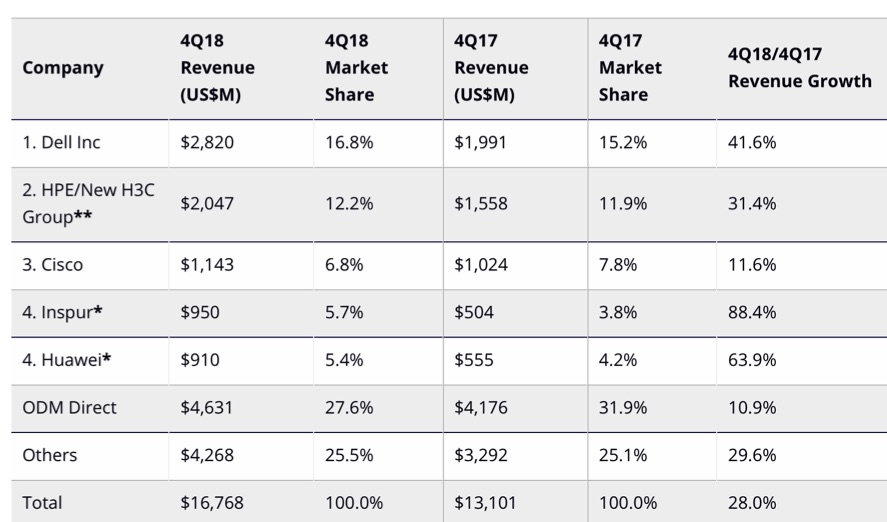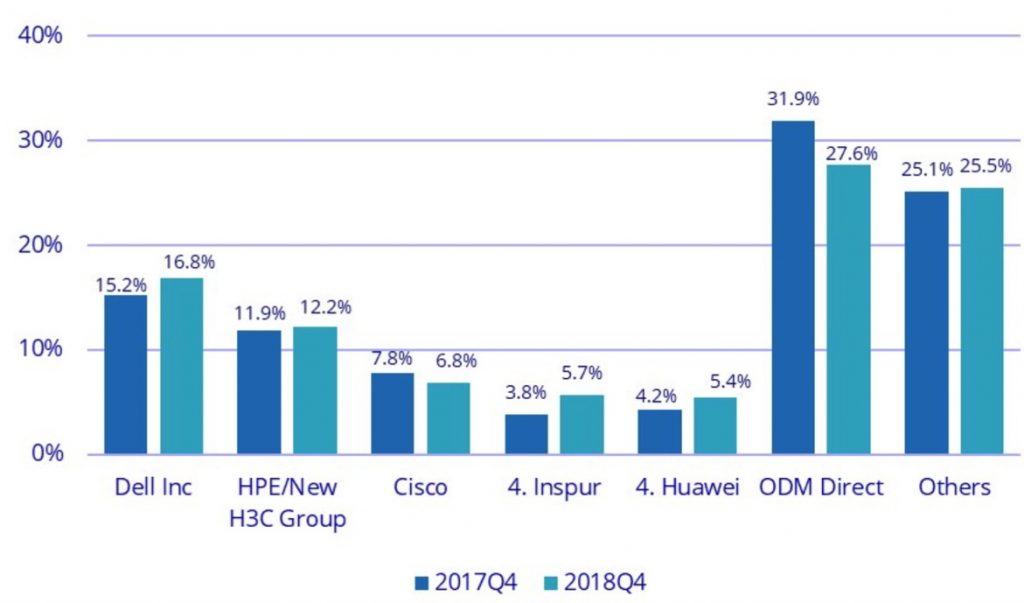Spending on Public and Private Cloud IT Infrastructure Totaled $66.1 Billion in 2018, Up 4.5% Estimated in 2019 – IDC
Led by Dell, HPE, Cisco, Inspur and Huawei in 4Q18
This is a Press Release edited by StorageNewsletter.com on April 5, 2019 at 2:40 pmAccording to the International Data Corporation‘s Worldwide Quarterly Cloud IT Infrastructure Tracker, vendor revenue from sales of IT infrastructure products (server, enterprise storage, and Ethernet switch) for cloud environments, including public and private cloud, grew 28.0% Y/Y in 4Q18, reaching $16.8 billion.
For 2018, annual spending (vendor revenue plus channel mark-up) on public and private cloud IT infrastructure totaled $66.1 billion, slightly higher (1.3%) than forecast in 3Q18.
IDC also raised its forecast for total spending on cloud IT infrastructure in 2019 to $70.1 billion – up 4.5% from last quarter’s forecast – with yearly growth of 6.0%.
Quarterly spending on public cloud IT infrastructure was down 6.9% in 4Q18 compared to the previous quarter but it still almost doubled in the past two years reaching $11.9 billion in 4Q18 and growing 33.0% year over year, while spending on private cloud infrastructure grew 19.6% reaching $5.75 billion.
Since 2013, when IDC started tracking IT infrastructure deployments in different environments, public cloud has represented the majority of spending on cloud IT infrastructure and in 2018 – as IDC expected – this share peaked at 69.6% with spending on public cloud infrastructure growing at an annual rate of 50.2%. Spending on private cloud grew 24.8% Y/Y in 2018.
In 4Q18, quarterly vendor revenues from IT infrastructure product sales into cloud environments fell and once again were lower than revenues from sales into traditional IT environments, accounting for 48.3% of the total worldwide IT infrastructure vendor revenues, up from 42.4% a year ago but down from 50.9% last quarter. For the full year 2018, spending on cloud IT infrastructure remained just below the 50% mark at 48.4%. Spending on all three technology segments in cloud IT environments is forecast to deliver slower growth in 2019 than in previous years. Ethernet switches will be the fastest growing at 23.8%, while spending on storage platforms will grow 9.1%. Spending on compute platforms will stay at $35.0 billion but still slightly higher than expected in company’s previous forecast.
The rate of annual growth for the traditional (non-cloud) IT infrastructure segment slowed down from 3Q18 to below 1% but the segment grew 11.1% Q/Q. For the full year, worldwide spending on traditional non-cloud IT infrastructure grew by 12.2%, exactly as forecast, as the market has started going through a technology refresh cycle, which will wind down by 2019. By 2023, we expect that traditional non-cloud IT infrastructure will only represent 40.5% of total worldwide IT infrastructure spending (down from 51.6% in 2018). This share loss and the growing share of cloud environments in overall spending on IT infrastructure is common across all regions.
“The unprecedented growth of the infrastructure systems market in 2018 was shared across both cloud and non-cloud segments,” said Kuba Stolarski, research director, infrastructure systems, platforms and technologies, IDC. “As market participants prepare for a very difficult growth comparison in 2019, compounded by strong, cyclical, macroeconomic headwinds, cloud IT infrastructure will be the primary growth engine supporting overall market performance until the next cyclical refresh. With new on-premises public cloud stacks entering the picture, there is a distinct possibility of a significant surge in private cloud deployments over the next five years.”
All regions grew their cloud IT Infrastructure revenues by double digits in 4Q18. Revenue growth was the fastest in Canada at 67.2% Y/Y, with China growing at a rate of 54.4%. Other regions among the fastest growing in 4Q18 included Western Europe (39.7%), Latin America (37.9%), Japan (34.9%), Central & Eastern Europe and Middle East & Africa (30.9% and 30.2%, respectively), AsiaPac (excluding Japan) (APeJ) (28.5%), and the United States (15.5%).
Top Companies, WW Cloud IT Infrastructure Vendor Revenue,
Market Share, and Y/Y Growth, 4Q18
(revenue in $ million)

WW Cloud IT Infrastructure Top 5 Vendors 4Q18 vs. 4Q17
(shares based on vendor revenue)

* IDC declares a statistical tie in the worldwide cloud IT infrastructure market when there is a difference of 1% or less in the vendor revenue shares among two or more vendors.
** Due to the existing joint venture between HPE and the New H3C Group, IDC will be reporting external market share on a global level for HPE as HPE/New H3C Group starting from 2Q16 and going forward.
Long-term, IDC expects spending on cloud IT infrastructure to grow at a five-year CAGR of 10.9%, reaching $99.9 billion in 2023 and accounting for 59.5% of total IT infrastructure spend. Public cloud datacenters will account for 68.3% of this amount, growing at an 10.4% CAGR. Spending on private cloud infrastructure will grow at a CAGR of 12.0%.
Taxonomy Notes
IDC defines cloud services more formally through a checklist of key attributes that an offering must manifest to end users of the service.
Public cloud services are shared among unrelated enterprises and consumers; open to a largely unrestricted universe of potential users; and designed for a market, not a single enterprise. The public cloud market includes variety of services designed to extend or, in some cases, replace IT infrastructure deployed in corporate datacenters. It also includes content services delivered by a group of suppliers IDC calls Value Added Content Providers (VACP).
Private cloud services are shared within a single enterprise or an extended enterprise with restrictions on access and level of resource dedication and defined/controlled by the enterprise (and beyond the control available in public cloud offerings); can be onsite or offsite; and can be managed by a third-party or in-house staff. In private cloud that is managed by in-house staff, ‘vendors (cloud service providers)’ are equivalent to the IT departments/shared service departments within enterprises/groups. In this utilization model, where standardized services are jointly used within the enterprise/group, business departments, offices, and employees are the ‘service users.’
Compute platforms is defined as compute intensive servers. Storage platforms includes storage intensive servers as well as external storage and storage expansion (JBOD) systems. Storage intensive servers are defined based on high storage media density. Servers with low storage density are defined as compute intensive systems. Storage platforms does not include internal storage media from compute intensive servers. There is no overlap in revenue between compute platforms and storage platforms, in contrast with IDC’s Server Tracker and Enterprise Storage Systems Tracker, which include overlaps in portions of revenue associated with server-based storage.













 Subscribe to our free daily newsletter
Subscribe to our free daily newsletter

